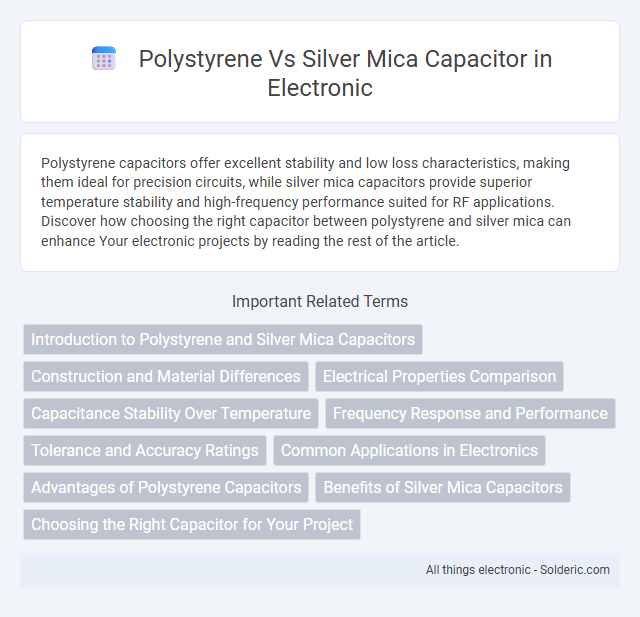Polystyrene capacitors offer excellent stability and low loss characteristics, making them ideal for precision circuits, while silver mica capacitors provide superior temperature stability and high-frequency performance suited for RF applications. Discover how choosing the right capacitor between polystyrene and silver mica can enhance Your electronic projects by reading the rest of the article.
Comparison Table
| Feature | Polystyrene Capacitor | Silver Mica Capacitor |
|---|---|---|
| Dielectric Material | Polystyrene | Silver Mica |
| Capacitance Range | 1 pF to 10 uF | 1 pF to 0.1 uF |
| Tolerance | +-2% | +-1% to +-5% |
| Temperature Stability | Excellent (-55degC to +85degC) | Superior (-55degC to +125degC) |
| Dielectric Loss | Very Low (Low ESR) | Extremely Low (Ultra-low ESR) |
| Voltage Rating | Up to 200 V | Up to 1000 V |
| Frequency Response | Good for audio and low RF | Excellent for RF and high-frequency |
| Size | Compact | Bulkier |
| Applications | Audio circuits, timing, filtering | RF circuits, oscillator, precision filters |
| Cost | Lower | Higher |
Introduction to Polystyrene and Silver Mica Capacitors
Polystyrene capacitors feature a plastic dielectric known for low dielectric loss and high insulation resistance, making them ideal for precision timing and audio applications. Silver mica capacitors use a mica dielectric combined with silver electrodes, offering excellent stability, low inductance, and high voltage resistance suitable for high-frequency circuits. Your choice depends on the need for either superior precision and stable capacitance (polystyrene) or high frequency performance and reliability (silver mica).
Construction and Material Differences
Polystyrene capacitors feature a dielectric made from a thin film of polystyrene plastic, providing low loss and stable electrical characteristics, while silver mica capacitors utilize naturally occurring mica minerals coated with silver layers, resulting in a robust, high-Q dielectric. The construction of polystyrene capacitors involves winding or stacking the polystyrene film between metallic electrodes, offering flexibility in shapes and sizes. Silver mica capacitors are built by layering thin mica sheets with silver electrodes, producing a rigid, heat-resistant component ideal for high-frequency applications.
Electrical Properties Comparison
Polystyrene capacitors exhibit low dielectric loss and high insulation resistance, making them ideal for precision filtering and timing applications. Silver mica capacitors provide superior stability, low tolerance, and excellent high-frequency performance due to their low temperature coefficient and low dielectric absorption. Both types offer excellent electrical properties, but silver mica capacitors excel in high-frequency circuits while polystyrene capacitors are preferred for low-frequency, high-precision tasks.
Capacitance Stability Over Temperature
Silver mica capacitors exhibit superior capacitance stability over a wide temperature range, typically maintaining tolerance within +-2% from -55degC to 125degC. Polystyrene capacitors, while also offering good stability, generally show a wider variation, around +-1% to +-3%, but perform best between -55degC and 85degC. The robust dielectric properties of silver mica make it more suitable for precision applications requiring minimal capacitance drift under thermal fluctuations.
Frequency Response and Performance
Polystyrene capacitors exhibit excellent frequency response with low dielectric loss, making them ideal for high-frequency applications where signal integrity is crucial. Silver mica capacitors offer superior stability and precision, maintaining consistent performance across a wide frequency range with minimal temperature and voltage variation. Your choice depends on whether you prioritize the low loss and smooth frequency response of polystyrene or the durability and accuracy of silver mica capacitors for demanding RF applications.
Tolerance and Accuracy Ratings
Silver mica capacitors exhibit superior tolerance and accuracy ratings, often as precise as +-1% or better, making them ideal for high-frequency and precision applications. Polystyrene capacitors typically offer good accuracy with tolerances around +-2%, but they can vary more with temperature changes and aging. Your choice depends on the need for highly stable capacitance in critical circuits versus cost-effective components with reasonable precision.
Common Applications in Electronics
Polystyrene capacitors are widely used in audio equipment, precision analog circuits, and timing applications due to their low dielectric loss and high stability. Silver mica capacitors excel in high-frequency RF circuits, oscillators, and microwave applications because of their superior temperature stability and low inductance. Understanding the strengths of each helps you select the ideal capacitor for your electronic design's performance requirements.
Advantages of Polystyrene Capacitors
Polystyrene capacitors offer superior stability and low dielectric absorption, making them highly suitable for precision analog circuits and timing applications. Their low dissipation factor and excellent insulation resistance ensure minimal energy loss and long-term reliability. Compared to silver mica capacitors, polystyrene types provide better tolerance to humidity and lower microphonics, enhancing performance in sensitive electronic devices.
Benefits of Silver Mica Capacitors
Silver mica capacitors offer superior temperature stability and precision due to their low temperature coefficient, making them ideal for high-frequency and RF applications. Their excellent reliability and low loss characteristics ensure consistent performance over time, outperforming polystyrene capacitors in critical circuits. High insulation resistance and minimal moisture absorption further enhance the durability and accuracy of silver mica capacitors under demanding operational conditions.
Choosing the Right Capacitor for Your Project
When choosing the right capacitor for your project, consider that polystyrene capacitors offer low loss and high insulation resistance, making them ideal for precision timing and low-frequency applications. Silver mica capacitors provide superior stability, low inductance, and excellent high-frequency performance, suitable for RF circuits and filters. Your selection depends on the required tolerance, temperature stability, and frequency range to ensure optimal functionality.
Polystyrene vs silver mica capacitor Infographic

 solderic.com
solderic.com